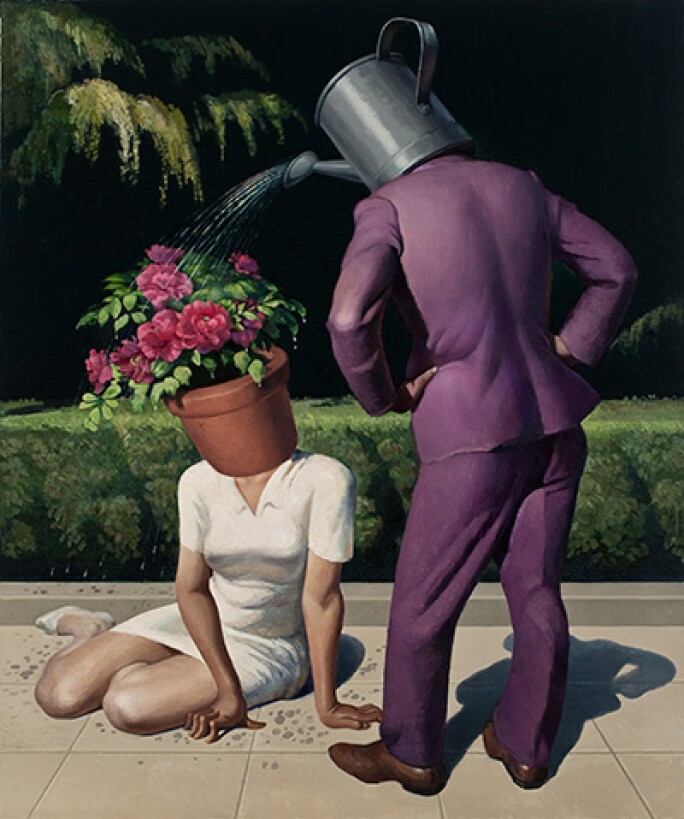BEIJING -- Artists of our time live in a great paradox: on the one hand, we want them to produce an instantly recognizable “signature style;” on the other hand, we expect them to constantly “re-invent” themselves in a linear progression. An artist without stylistic developments is as aesthetically undesirable as commercially unmarketable.

Wang Xingwei’s Untitled (Watering Flowers), 2013. PHOTO: COURTESY OF THE ARTIST AND GALERIE URS MEILE.
Wang Xingwei (b. 1969) would have none of either: “I consider the artist as a postman. He should not be overly curious about what is inside the envelopes he delivers.” In some sense, he is also denying the viewers their inquisitiveness about what is inside the envelopes.

Exhibition view of Wang Xingwei at the Ullens Center for Contemporary Art.
Drawing freely from both Eastern and Western pictorial motifs, and deploying wide-ranging techniques and styles that are traditionally associated with 19th-century French Realism, Post-Impressionism, Photo Realism, Socialist Realism, Surrealism, Cynical Realism and Political Pop, to name just a few, Wang has steadfastly refused to abide by a consistently recognizable style. As I walked through a mid-career survey of Wang's work at the Ullens Center for Contemporary Art (UCCA), organized by the Center’s Director Philip Tinari, I found in his often-cryptic pictorial references a deliberate resistance to many of our preconceived interpretative frameworks.

The Oriental Way: The Road to Anyuan, 1995.
Rather than organizing his works in a chronological order, the artist chose to show them in three categories: front, back and lateral views, each corresponding to the side of the dominant figures facing the viewers. For instance, The Oriental Way: The Road to Anyuan (1995) substitutes the back view of the artist for the heroic frontal view of Mao in the iconic Social Realist painting titled Chairman Mao Goes to Anyuan (1967). The original version by Liu Chunhua, painted in the heyday of the Cultural Revolution (1966-1976) and depicting Mao on his way to lead a miners’ strike, was reportedly the most reproduced oil painting in human history, with 90 billion posters printed.
Wang’s works are full of seemingly haphazard art historical references and self-references. His cartoonish depictions of several other contemporary artists in Red East (1995) are also re-appropriations of these fellow artists’ styles. On the other hand, Wang’s representational Surrealism, such as human subjects sporting potted-plant heads in Untitled (Watering Flowers) (2003), reminds us of the surreal styling of Belgian surrealist artist, René Magritte (1989-1967). Magritte described his own paintings as “visible images which conceal nothing; they evoke mystery and, indeed, when one sees one of my pictures, one asks oneself this simple question, ‘What does that mean?’ It does not mean anything, because mystery means nothing either, it is unknowable.” In a similar vein, Wang declared: “I think we should forget traditional art history and use a living kind of thought to define ourselves, finding value in pure self-expression.” Perhaps a “no-comment” on the prevalent youth culture, his A Sunday Afternoon in the Youth Park (2009) depicts stylish young lovers posing in front of an unlikely romantic spot— one of China’s notorious public restrooms.

Untitled (Watering Flowers) (sketch), 2009. PHOTO: COURTESY OF 01100001 (BEIJING) AND GALERIE URS MEILE.
Concurrently with the UCCA show, Galerie Urs Meile and 01100001 Gallery are showing 100 sketches and original paintings selected from a large number of paper works that Wang has accumulated over the past twenty years. Described as the first exhibition in China that systematically displays the genuine sketches of a contemporary artist, this visual treat allows one to take a glimpse at the inner workings of the ineffable sense of theatricality which Wang carries out in his paintings.
WANG XINGWEI
Ullens Center for Contemporary Art
798 Art District
Beijing, China
19 May – 18 August, 2013
WANG XINGWEI (SKETCHES)
01100001 (Beijing)
In collaboration with
Galerie Urs Meile, Beijing-Lucerne
Caochangdi Art District
Beijing, China
18 May – 30 June, 2013
Chiu-Ti Jansen is a TV presenter, a publisher and a writer based in New York City with a pulse on China.